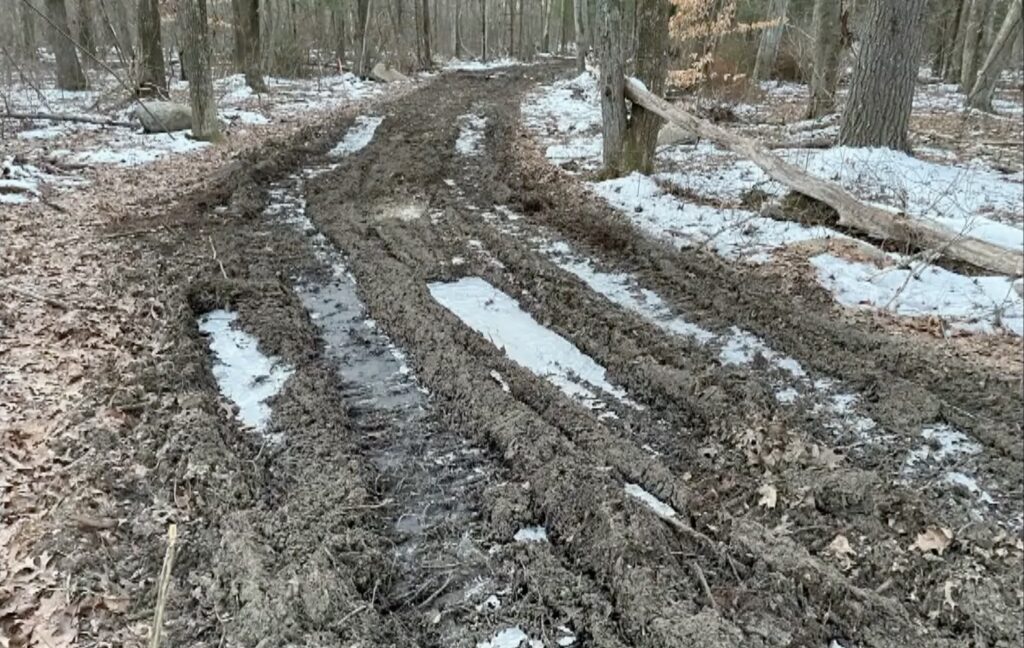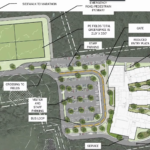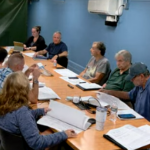Plans to drill a test well for the Elmwood School replacement project were derailed when weather impacted creation of a temporary road to the site.
Chris Eberly, Vertex project manager, explained at Tuesday’s Elementary School Building Committee meeting that the intent was to cut out a road to the back of the woods for the drilling. However, warmer than expected weather resulted in areas of standing water.
The plan was to use riprap and large-diameter stones over the areas not freezing to create a drivable surface, he said.
Work began last Wednesday into Thursday, Eberly said, but as the ground thawed, the moisture thawed from the top down.
Because the area previously was a farm, it also has loam.
“The loam that is there has a pumping effect up onto the road,” Eberly said. “Muck and dirt pushed up everywhere the excavator drove.”
Mud, water and a layer of ice made it difficult to spread much stone, which ended up sinking into the dirt, he said. “We had intended to make use of frozen weather … but it was not successful as we all had wished.”
The contractor hired to do the digging said the road would be “impassable” for the drill rig and he “can’t move forward,” Eberly said. Eberly told him to stop working.
However, he told the Elementary School Building Committee that concurrently, digging for a test well is underway for the Hopkins School addition project. He said an option would be to use that data for the Elmwood replacement school, too, as it should have “a reasonably close data point.”
Eberly said the test well serves as the first permanent well.

Due to unseasonably warmer weather, the temporary road to the new school site is not firm enough for construction vehicles. PHOTO/VERTEX
Other options were to wait until summer when it is drier, assuming that the weather will not be cold enough earlier, or moving the site closer to the edge of the road near Marathon School, but that was not advised.
“Once you drill the first one, you’ll have a much better idea based on Hopkins’ data,” said Mike Shepard, ESBC member. “Weather is something we can’t depend on.”
To date, approximately $5,800 has been spent within the existing budget for this purpose, according to Vertex vice president Jeff D’Amico. The board authorized $10,175 to pay the “sunk costs” so far as well as cleanup costs, etc.
Director of Facilities Tim Persson noted there are “piles of riprap” still at the site.
When Hopkins’ data comes back, the issue will be revisited.
The board also authorized up to $25,000 for ancillary costs up through the design phase. The idea, said D’Amico, is to avoid waiting in between meetings to get work done.
Lockers vs. cubbies discussed
The committee looked at photos and renderings of the landscaping scheme as well as outdoor classrooms.
“It’s nice to see these [outside] spaces come to life,” said ESBC chair Jon Graziano.
He said that landscaping can make the size of the building less intimidating.
A discussion occurred while board members were looking at “breakout space” options.
Vice chair Tiffany Ostrander questioned having stationary lockers against walls in a corridor rather than something that could be moved in case there was a need to use the space for groups.
Shepard pointed out she was bringing an educator’s perspective. “But from a building inspector standpoint, if the stuff in the hallway gets moved around, it could impair egress and the safety of students,” he said.
Eberly said his company would be talking to teachers to devise strategies on the best way to program space.
Graziano asked if it was common to have lockers for the age group (Grades 2-4) that will attend the new school.
Persson said Marathon School has open-faced “cubbies” with hangers where kids put their belongings.
Eberly said educators had expressed a need to get belongings out of the classrooms. He said he would be meeting with focus groups in late February or early March, and they could discuss “lockers versus cubbies” further at that time.
Graziano said he was most interested in hearing feedback from users of the school — teachers, principals and facilities personnel.
Outreach planned to Environmental Justice Community
In addition to stakeholder meetings to talk about “how concept ties to curriculum,” Eberly said he would be reaching out to residents in the Environmental Justice Community (an area of town abutting Ashland) via a forum March 11.
Input from that session will be submitted to the Massachusetts Environmental Policy Act (MEPA) office in late April
The requirements from MEPA include this outreach as well as questions and input from various state agencies, said D’Amico.
It will take about nine months for the MEPA process to play out — likely until January or February of 2025. The process will occur at the same time as town boards conduct their permitting processes.






















One other interesting thing that is not mentioned in the article, is that the town will not receive MSBA payments for this project until the MEPA review is complete. Discussion is at around the 1:15 mark. It seems as though MSBA feels there is some risk around this MEPA process, so they hold back funding. Is anyone concerned about that?
The reason for all the water is not that it was a farm and the land is fertile. What a joke. It is a wetland. If I tried to build a house there it would have been denied in a heartbeat. Go back there and look it is always wet.